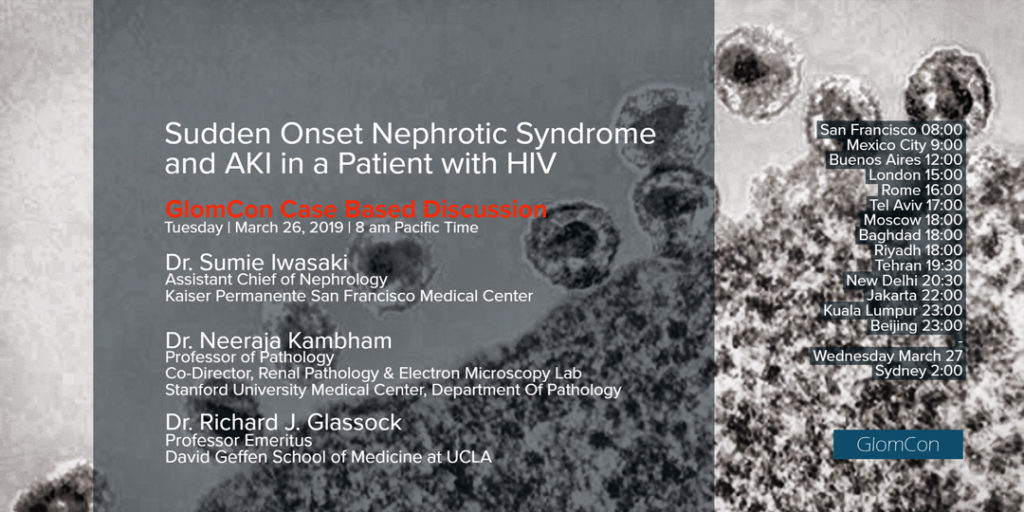CASE-BASED DISCUSSION
Sudden Onset Nephrotic Syndrome and AKI in a Patient with HIV
A case-based discussion led by Dr. Sumie Iwasaki, Dr. Neeraja Kambham and Dr. Richard J. Glassock. Our Moderator’s Notes are derived from their live presentation.


By Dr. Jorge Castaneda
Key Points
The differential diagnosis for sudden onset of nephrotic syndrome and AKI in a patient with HIV is broad and should include proteinuric disorders possibly related to the underlying HIV, as well as other HIV unrelated causes of nephrotic syndrome.
Examples specific to this case mentioned include:
A. HIV related glomerular disorders
a. HIVAN (HIV associated nephropathy): Almost exclusively affecting APOL1 risk allele carriers and in patients with high viral activity, not on HAART.
b. HIVICK (HIV associated immune complex disease): A diagnosis of exclusion, presenting as a “lupus like” pathology.
B. HIV unrelated glomerular disorders
a. Post infectious glomerulonephritis
b. Ig-A nephropathy
c. Cryoglobulinemic GN (related to HIV or due to the high prevalence of hepatitis C co-infection, hepatitis C related)
d. Fibrillary GN
e. Membranous nephropathy (primary or related to potential co-infection with hepatitis B)
f. Amyloidosis (AA or AL)
g. ANCA vasculitis
h. Minimal change disease (and AKI due to severe proteinuria)
While the complexity of the presentation discussed did not lend itself to a unifying diagnosis, a focus of the didactic was on cryoglobulinemic GN.
Here, a Brief review of cryoglobulinemia:
What are cryoglobulins?
• Cryoglobulins are immunoglobulins (Igs) that precipitate in vitro at < 370C and resolve on rewarming.
• Cryoglobulins are classified according to Ig composition (Brouet Classification), which is determined by immunofixation of the cryoprecipitate.
Type I.- Monoclonal Igs – typically IgG or IgM, rarely IgA Monoclonal gammopathies (MM, Waldenstrom, CLL)
Type II (mixed).- Monoclonal IgM (“rheumatoid factor”) against polyclonal IgG. HCV primarily, but also HBV, HIV, autoimmune diseases (SLE, Sjogren)
Type III (mixed).- Polyclonal Igs (all isotypes) and polyclonal IgM Autoimmune disease or infection (rarely HCV)
• Cryoglobulins can form in association with hematologic malignancy (lymphoma, myeloma), viral infection (HCV, HBV, HIV), or auto-immune conditions (e.g. SLE, rheumatoid arthritis, Sjogren); no underlying cause is identified in ~10%.
• The presence of cryoglobulins does not always result in disease.
HCV associated cryoglobulinemia:
• Up to 50% of patients with HCV have positive circulating cryoglobulins but only 5% develop clinical manifestations.
• HCV-associate cryoglobulinemia is most commonly type II (mixed) and can occur in the absence of a detectable viral load.
HIV associated cryoglobulinemia
• The prevalence of cryoglobulins in HIV infection (without concomitant hepatitis C) is 6%, although levels are usually low, and patients are rarely symptomatic.
• Unlike HIV associated nephropathy (HIVAN), HIVICK is not associated with high risk APOL1 alleles.
• Several cases of HIV infection and typical fibrillary or immunotactoid GN, in the absence of HCV, have also been reported. DNA JB9 staining might be a useful tool to identify fibrillary GN when EM is not available.
Treatment of (symptomatic) cryoglobulinemia:
• Treatment is primarily directed against the underlying cause, although Rituximab or PLEX can more rapidly reduce serum cryoglobulin levels
• Indications for PLEX in cryoglobulinemia include:
o Symptomatic cryobulinemic vasculitis (? crescentic GN).
o Cryoglobulin levels > 300-500 mg/dl.
o Prior to Rituximab therapy to prevent serum sickness (patients with low C4 with high RF and/or high cryoglobulin levels are at greatest risk).
Selected References:
• https://www.ncbi.nlm.nih.gov/pubmed/21868085 1
• https://www.ncbi.nlm.nih.gov/pubmed/?term=30128338
• https://www.ncbi.nlm.nih.gov/pubmed/27477364
